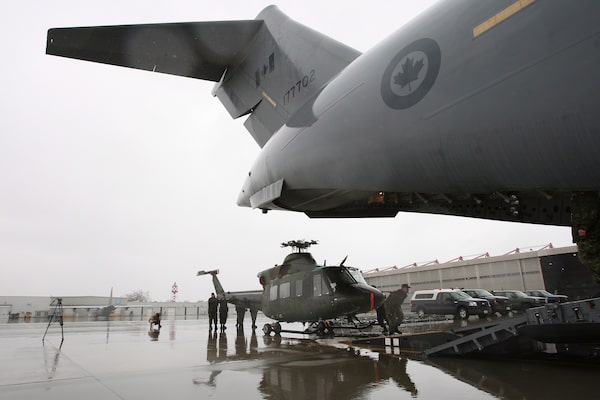
A CH-146 Griffon helicopter from Canadian Forces Base Bagotville, is loaded onto a C-17 Globemaster airplane, at Canadian Forces Base Trenton in Trenton, Ont., on Nov. 17, 2013.Lars Hagberg/The Canadian Press
The federal government’s long-promised defence policy update has been kept under wraps since 2022 because the Trudeau cabinet is struggling with the cost of big-ticket items, such as new submarines, tanks and drones, at the same time that the United States is pressing Ottawa to boost military spending, according to a senior official.
The official, who is familiar with the nearly two-year-old review, said the delay in releasing the defence update has frustrated military commanders who want to see major spending to meet Canada’s commitments to NATO and NORAD.
The Defence Department submitted various options to the cabinet but the government keeps delaying publication because of the “sticker shock” for new equipment, the official said.
The Globe and Mail is not identifying the official, who is not authorized to speak about the matter.
The last policy update was published in 2017, before Russia’s 2022 military assault on Ukraine and the rise of an increasingly belligerent China – developments that have prompted Western countries including Britain, France, Germany and Poland to increase military spending.
In the 2017 defence review, the federal government pledged to hire more soldiers and place “added attention on improving recruitment, retention, and training to capitalize on the unique talents and skillsets of Canada’s diverse population.”
However, Canada’s military is considered about 16,000 members below full strength and its branches are operating below readiness thresholds half the time.
In March, 2022, the government said it would bring in a defence review and promised to boost “the defence budget by $553-billion over the next 20 years.” The review has yet to appear.
David Perry, president of the Canadian Global Affairs Institute think tank, said there are about $100-billion of unfunded capital asset replacement projects that are needed right now.
“If they want us to keep having submarines, we have to buy new ones. If we want to keep having main battle tanks, these have to be replaced. There is no replacement on the books for the Kingston class coastal defence vessel. The Griffon tactical helicopter that supports the army is being upgraded but they are going to need to be replaced because they are getting pretty old,” Mr. Perry said.
“There are a lot of reasons to get on with this defence policy review, which just seems to be dragging interminably,” he said. “The [Defence] Department had briefed government multiple times on different options and basically they are waiting for an answer.”
Mr. Perry also said the international defence industry has been so pressed trying to supply Ukraine with weapons that this has led to huge inflationary effects on military budget items, particularly for equipment acquisition.
Canada signed on to a NATO communiqué last July that stated parties to the military alliance would “make an enduring commitment to invest at least 2 per cent of our Gross Domestic Product (GDP) annually on defence,” with one-fifth of that going toward major equipment and research and development.
While Ottawa agreed to this target, the government has not set out a road map to reach it. NATO released estimates in March saying Canada is only spending 1.33 per cent of GDP on defence. These figures show Canada is still far short of the 2-per-cent GDP target and the 20-per-cent commitment for equipment and research and development.
“Our comparative stance in NATO is slipping appreciably. Canada is now the sole ally that doesn’t meet either of the NATO investment targets because we are falling way short of spending 2 per cent and we are also falling short of spending 20 per cent on equipment purchases,” Mr. Perry said.
The U.S. and other allies are also pushing Canada to increase its military presence in the Arctic, where Russia and China are co-operating.
Daniel Minden, communications director for Defence Minister Bill Blair, referred The Globe to several comments made by the minister in which he suggested the government might unveil the defence review near the 75th anniversary of NATO, which is being commemorated in Washington in July.
“I’m very confident that the government will be bringing more information on that, certainly in leading up to the NATO Leaders Alliance meeting that’s going to take place in Washington,” Mr. Blair told Global TV’s The West Block.
He wouldn’t answer questions about whether the government will actually meet the 2-per-cent target that Prime Minister Justin Trudeau pledged at last year’s NATO summit in Vilnius.
In a speech earlier this month at the Ottawa Conference on Security and Defence, Mr. Blair mentioned some areas that Canada must invest in – including domestic capacity to produce artillery ammunition, long-range precision strike capabilities, persistent underwater surveillance capabilities and a network of Arctic infrastructure.
 Robert Fife
Robert Fife Steven Chase
Steven Chase